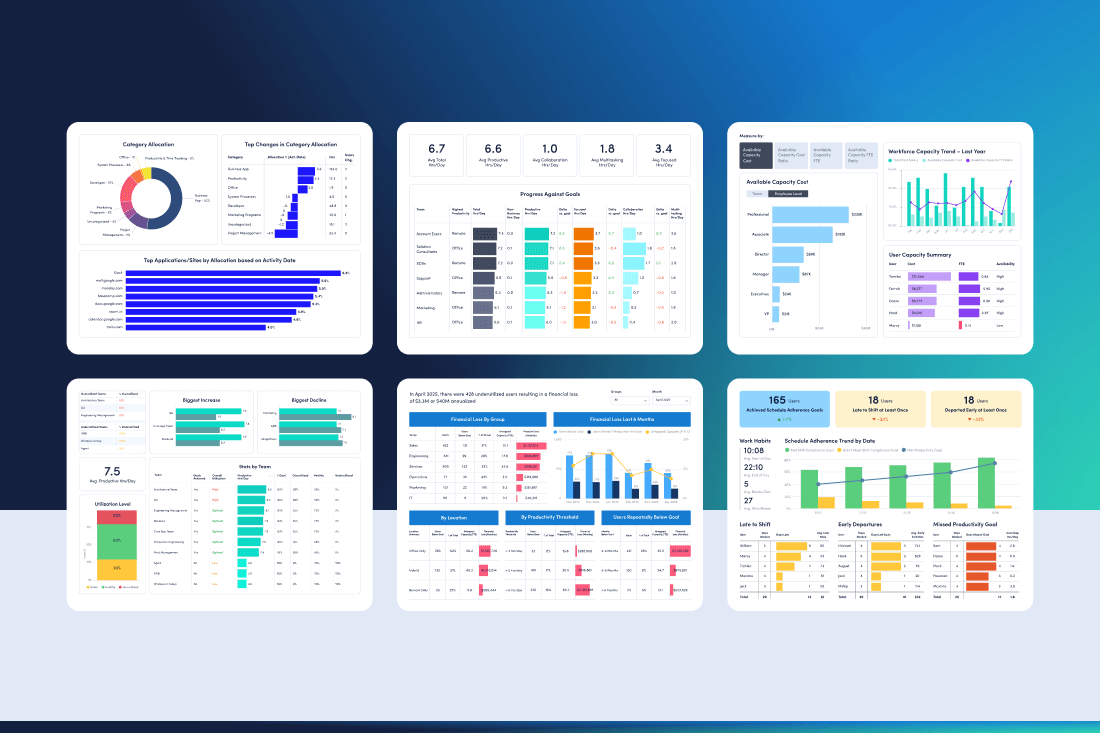Time management is a critical skill that significantly impacts productivity and efficiency. But unfortunately, not every employee values or practices good time management skills. As a manager, it’s your job to help people manage their time effectively and understand why the skill is so important.
Explore ways to help your employees enhance productivity and reduce stress in this time management guide for managers.
Benefits of time management in the workplace
When employees effectively manage their time, the organization and workers see many key benefits:
- Enhanced productivity: Well-managed time means employees complete their work more efficiently.
- Higher quality work: Employees with good time management skills focus on their work and double-check it for quality issues.
- Reduced stress levels: When employees are in control of their schedules, they experience less anxiety from overwhelming workloads and looming deadlines.
- Better morale and engagement: A sense of control over their time gives employees more job satisfaction and fosters a more positive work environment, leading to better employee engagement.
- Enhanced work-life balance: Employees who effectively prioritize tasks have more time for personal activities to reduce burnout and increase overall well-being.
- Resiliency: Planning, organization and prioritization help employees handle unexpected challenges.
- Improved collaboration: When every team member is clear about their schedules, deadlines and priorities, it’s easier to collaborate to achieve common goals.
Explaining the impact of time management on an organization
While some employees may not understand the value of managing their time, poor time management has very real impacts on organizations. When a task takes longer than expected, it incurs a time cost on the company in the form of higher labor costs, missed opportunities and decreased productivity.
Rushed work often means more mistakes, which leads to spending even more time fixing issues. Missed deadlines mean more work for team members who may already be struggling with their own priorities. Over time, trust breaks down and team members may stop relying on each other — leading to lower overall morale across the organization.
When work isn’t completed on time or to quality standards, customer service struggles as well. Clients lose faith in an organization’s ability to meet its promises, which creates a bad reputation for the company. This has a ripple effect on recruiting and retention as prospective employees start to suspect issues behind the scenes.
Employees may see time management procedures as another task that adds to their workload. However, understanding how long a task should take and using intentional project time management can prevent negative issues from popping up in the first place. It’s important to communicate the importance of time management clearly with employees, and to create a culture where effective time management blossoms.
Why employees struggle with time management
There are several common reasons employees struggle with time management, and understanding them is critical for improving the skill.
The overwhelm of modern work environments
Constant emails, meetings and unexpected tasks make it challenging for employees to focus on their priorities. This barrage of distractions leads to ineffective multitasking, which lowers productivity. The rise of remote work has also blurred the lines between personal and professional time, making it even more difficult for employees to carve out dedicated periods for focused work. The temptation to check messages or engage in non-work-related activities during work hours makes time management issues even worse.
Lack of training and resources
Many employees just aren’t equipped with the skills or tools needed to manage their time effectively. Without proper guidance, they may find it difficult to set realistic goals or prioritize tasks appropriately. Organizations that don’t invest in time management training miss the opportunity to empower their workforce. Workshops or access to productivity tools have a profound impact in helping employees develop strategies that align with their unique workstyles. Organizations must also create a supportive culture that encourages open communication about workload to ensure employees don’t feel isolated in their struggles, especially when working in a hybrid or remote work environment.
Fear of failure
Perfectionism and fear of failure hinder employees from managing their time well. Some may spend excessive time on a single task, aiming for perfection, while others procrastinate due to anxiety about their performance. The pressure to meet high expectations, whether self-imposed or organizational, can lead to a cycle of stress and inefficiency. And if managers respond negatively to mistakes, employees shy away from taking risks or trying new approaches for completing tasks.
4 practical time management techniques to share with employees
Implementing effective time management strategies helps employees optimize their work processes. Here are four practical strategies you can share and adopt within your team.
1. Time blocking
Time blocking involves scheduling specific blocks of time for different tasks or activities. Employees can minimize distractions and enhance concentration by allocating dedicated time slots for focused work. Encourage your team to create a weekly schedule that outlines tasks and commitments so they can visualize workloads and prioritize effectively. Encourage them to mark focus time as “busy” on their calendars so other employees can’t schedule meetings or interrupt them.
2. Pomodoro Technique
Using the Pomodoro Technique, employees break their work into intervals called “pomodoros,” traditionally 25 minutes long, separated by short breaks to maintain focus and stave off fatigue. The technique was named after a tomato-shaped timer (pomodoro is Italian for tomato) — use any timer to set regular break intervals. Studies show recharging through breaks increases productivity and creativity.
3. Task batching
In task batching, employees group similar activities to minimize context switching or multitasking. For example, rather than responding to emails as they come in throughout the day, employees set a specific time to handle all communications. This leads to greater efficiency and a more streamlined workflow, which allows employees to complete tasks faster and with less mental fatigue.
4. Eisenhower Matrix
Named after President Dwight D. Eisenhower, the Eisenhower Matrix, or Urgent-Important Matrix, is a powerful tool for prioritizing tasks based on urgency and importance. Employees categorize tasks into four quadrants: urgent and important, important but not urgent, urgent but not important or neither urgent nor important. This allows them to make informed decisions about where to focus their time and energy. This technique encourages strategic thinking and helps prevent burnout from less critical tasks.
How real-life companies create a culture that supports better time management
Managers need to create a culture that supports time management. This starts by modeling the behavior themselves, but there are many other ways to show the value of time management and support employees to make better decisions.
Understand how employees use their time
Missed deadlines and negative employee feedback about workloads are surefire signs there’s a time management issue in the workplace. Managers who understand how employees use their time can spot and fix issues before they lead to bad outcomes. This kind of data provides much better insights into employee efficiency and time use than self-reporting or simple task completion metrics can give.
For example, Echo Global Logistics leveraged ActivTrak workforce efficiency insights to see where employees were using time effectively and where it was wasted. They immediately noticed employees were spending 43% of their time checking emails, which led to new conversations around automating email tasks and email policies. Managers also spotted employees who were completing tasks much faster than others or had more time on their hands, allowing them to better balance workloads and help underutilized employees find more meaningful work.
Track productivity across time of day and location
Beyond seeing how employees use their time, managers can empower better time management by understanding when and where employees are most productive. This is especially important for making decisions around flexible, hybrid or remote work schedules. Armed with proof that employees are more productive at home or in the office, managers can justify workplace policies.
One leading healthcare organization used ActivTrak’s strategic workforce analytics to reinforce its decision to offer remote work. Based on real-time productivity data, leaders proved employees were completing tasks and doing high-quality work from remote locations — and continued offering remote work and flexibility. They also balanced workloads in overnight shifts to ensure escalated support groups had the right resources to perform their best even during non-traditional hours.
Give employees objective insights into their time use
Sometimes employees don’t know how much time they’re spending on given tasks or unproductive work. By giving them objective measurements of their time use, you help them make better decisions. Managers can also use the data to find better ways to support employees in their time management efforts.
Using ActivTrak’s productivity monitoring tool, FAM Brands showed employees data on how much time they spent on important work, multi-tasking or collaboration activities like meetings, chats and emails. This insight led to big changes in training employees on how to use tools and apps that were taking more time than they warranted. It also empowered managers to cut down on the number of meetings they held to give employees more time for focused work. Employees got access to personal insight dashboards to plan their days more effectively.
Empower employee time management skills with ActivTrak
Managers who prioritize time management at work empower their employees to be more productive, less stressed and more satisfied with their jobs. Providing team members with the right time management tools to meet deadlines is a good start, but it’s important to go deeper with insights and data.
ActivTrak’s workforce analytics software gives managers a complete picture of work habits so they can help employees make better time management decisions. Understanding where, why and when slowdowns happen allows you to provide better training, guidance and support to employees. Get a free demo of ActivTrak to see how you can improve time management in your organization through better data and insights.





